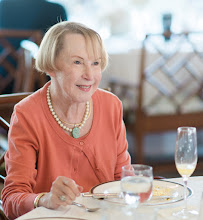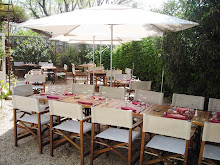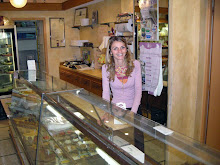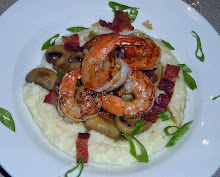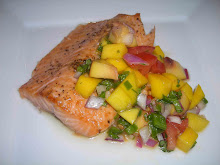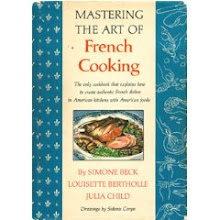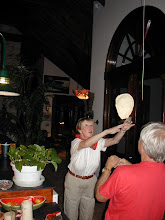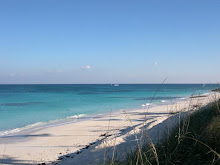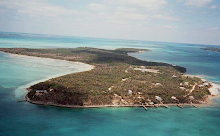Our favorite Boucherie in Saint-Remy was Chez Marc & Maryse. They were a butcher shop as well as a Charcuterie, a pork butcher. We had peeked in the front window of Boucheries on our previous visits to France but had never actually ventured inside because we weren’t staying where we could cook. On this trip we rented a house for two months because our top priority was to have our own kitchen so we could experiment with the wonderful foods in the market and shops.
We bravely entered their shop armed with a handwritten note of what we wished to purchase, written in French. We wanted to make our own steak tartare, a raw beef mixture seasoned with parsley, onions, mustard, capers, anchovies and a raw egg yolk, and serve it for dinner on the crusty French baguettes we had purchased earlier in the day. Inside we found a tiny shop with showcases filled with all sorts of beautiful meats, cheeses, pates, and daily specials of already prepared meals to take out.
Marc was busy behind the counter rolling and tying a gorgeous crown roast for a customer. There were two other patrons in the shop so our turn would come after theirs. It was a surprisingly long wait because Marc was alone in the store and he pays his full attention to the current customer and everything is cut and prepared to order. The wait was far from unpleasant because it gave us time to ooh and ah over the gorgeous variety of pates, meats and cheeses in the case. We admired the beautifully larded and decorated prepared roasts, the filets of lamb and the brochettes of beef with tomatoes. In the poultry case there were the famous Bresse chickens. Bresse is a breed of chicken highly valued for their rich gamey flavor yet tender flesh. World gourmet experts consider the Bresse chicken the best tasting in the world. Demand is so high that few make it outside France. There was lapin, French rabbit and canette, female ducklings.
When our turn came my husband said, “Bonjour monsieur. Parlez-vous anglais?” hoping Marc spoke some English. In some of the other shops in town we usually got the answer, “Oui, un peu, a little.” No such luck here. “Non, monsieur,” Marc said.
My husband said no problem. He then bravely proceeded in his very best French, “Je voudrais un demi kilo boeuf hache, s’il vous plait,” and crossed his fingers that Marc would understand that we wanted a pound of ground beef and at the same time not ask us a question in return that we wouldn’t understand. Marc carefully patted the ground beef into a beautifully formed patty, placed it on a piece of white butcher paper and proceeded to weigh it. My husband reached over and took a pinch of the meat and ate it, hoping to indicate to Marc that we planned to eat it raw. Marc understood, then said something in French which we didn’t understand, reached in the counter and handed my husband a pinch of another ground meat for us to try. He called it “keffte” and it was his special house blend of steak tartare. It was nicely seasoned and very similar to how my husband makes his. We made a mental note to buy Marc’s house blend on our return visit.

We tried all of the different pates Maryse made. She had a gorgeous assortment of traditional French pates. Some were whipped smooth and contained the finest of goose and duck foie gras with other luxurious ingredients such as wine, port, or smoked salmon. Others were pork-based country style pates flavored with piquant black pepper. They were so beautiful that one day we asked her if she had studied at The Cordon Bleu, the prestigious culinary school in Paris. “Non monsieur,” she said as if everyone in France made fancy pates such as these. By the same token I could tell she was flattered by our comment.
She also prepared daily take-out specials which were quickly gone by noon. A couple of times we were lucky enough to find ris de veau, sweetbreads, as the special. They were out of this world in her light cream sauce. Lasagna was also a frequent special, which surprised us until we remembered how close to Italy that Provence actually is. In fact, from Provence you can easily drive to Nice and back in one day. Nice was once part of the Italian Riviera and didn’t join France until 1860.
We went to Marc and Maryse’s shop at least three times a week during our two month stay. Often, but not always, another customer in the store spoke a little English and could help Marc understand what we were trying to say. Our French continued to improve and we felt more comfortable ordering in French. We learned that the wait could be long because Marc devoted his entire attention to one customer at a time and we planned accordingly. One day Marc put stemmed wine glasses on the counter, popped the cork of a local Cote du Rhone wine, poured three glasses and we toasted to our new friendship. When we returned home at Christmas we sent them a card with a handwritten note in French wishing them Joyeux Noel and saying how much we enjoyed getting to know them. Much to our surprise, a card from them appeared in our mailbox in North Carolina, written somehow in English, wishing us a Merry Christmas along with a short note thanking us for our friendship - a touching and very special moment for us. Whoever says the French aren’t nice to Americans doesn’t know what they are talking about.
The Supermarche in Saint-Remy was the equivalent of our supermarket. Compared to most of the charming shops in Provence, it’s not much to look at from the outside. One of the first things you notice is that the shopping carts are outside and chained to each other. Puzzled, we paused and watched as the lady in front of us inserted a euro in the slot and her cart came free. We proceeded to do the same and followed her inside of the store with our cart.
Once inside we passed through a selection of clothing, books and music on our way to the food section. Many of the aisles looked similar to a US supermarket with cereals, coffee, canned goods, bottled waters, laundry detergents, paper products and the like. On one aisle we saw a huge selection of Nutella, a creamy, chocolaty hazelnut spread, in every size imaginable. We learned later that Nutella spread on a slice of baguette is the snack of choice of many French children when they return home from school in the afternoon.
The produce section was large and offered a nice selection, but the fruits and vegetables paled in comparison to the beauty of the fresh produce brought by local farmers to the weekly outdoor market downtown in the square. However, it was fun to use the tongs to select your baby lettuces from the basket as opposed to buying it in a prepackaged plastic bag like we do in the US. Everything was priced in kilos, which at first glance seemed high until we remembered that a kilo is two pounds.
The fish market was our favorite spot in the Supermarche. As you can see from the picture, a lot of the things were out in the open, iced down for display. All very enticing with exotic offerings from the nearby Mediterranean Sea.
When we finished shopping we headed for the check-out line which was a real learning experience. For one thing French checkers are tres vite, very fast, and voila, before you know it, your purchases have been pushed to the end and it’s time to bag and pay. Here you must bring your own bags and bag your own. I purchased a large, sturdy straw market bag with leather handles so I would feel French just for the purpose, but unfortunately I wasn’t a tres vite bag person, which could tend to be embarrassing at times as a foreigner. But, with a good attitude, I didn’t let that stop me from shopping at the Supermarche. After all, we came to France to enjoy the food.
Afterwards, you take your shopping cart back out to the parking lot and return it to the cart line. As soon as you push the cart in, out pops your euro. Tres cool. It was a very clever way the French controlled the shopping carts and kept their parking lot tidy. US supermarkets could take a lesson from the French when it comes to shopping carts.
There were many funny things as well as some embarrassing moments that happened to us on this trip, but the one in the Supermarche probably takes first prize.
One day our shopping list was short so we decided to skip picking up the cart in the parking lot and instead use one of the hand held plastic baskets inside the store. Everything worked perfectly fine until it was time to check out. I didn’t know that I should have placed the plastic basket down in the bin provided at the beginning of the check-out counter. Instead I took the basket to where our groceries were accumulating from being checked. All of a sudden a very loud alarm went off and everyone started looking at me, including customers. The checker said something fast in French that sounded very much like a scolding and wagged her finger at me. That’s when I realized I’d done something terribly wrong and the alarm was going off because of me. As quickly as I could say, “Je suis desole,” she snatched the plastic basket, stomped around the counter and deposited it at the beginning of the check out line where I should have put it in the first place. I continued to say desole over and over again to no avail. Apparently the basket set off the alarm. Believe me, it’s important to know how to say “I’m sorry” in a foreign language and, I might add, have a good attitude . In fact I rank knowing how to say I’m sorry right up there with knowing how to ask where the bathroom is.
I hope you can join us next time as we visit a winery as we reminisce about our 2007 culinary adventure to Provence. Until then, a bientot.




















































